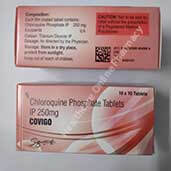113 customer reviews) | 114563 Viewed
Active Ingredient (Generic Name): Hydroxychloroquine
Indication: Antimalaria
Manufacturer: Molecule Impex Trading Company
Packaging: 10 Pills in 1 strip
Delivery Time: 6 To 21 days
Categories: Erectile Dysfunction, Men's Health


| Quantity | Price | Price/Unit | Add To Cart |
|---|---|---|---|
| 30 Pills | $44.99 | $ 1.5 | Original price was: $64.99.$44.99Current price is: $44.99.Buy Now |
| 60 Pills | $75.99 | $ 1.27 | Original price was: $95.99.$75.99Current price is: $75.99.Buy Now |
| 90 Pills | $94.99 | $ 1.06 | Original price was: $114.99.$94.99Current price is: $94.99.Buy Now |
| 180 Pills | $149.99 | $ 0.83 | Original price was: $169.99.$149.99Current price is: $149.99.Buy Now |
| 250 Pills | $169.99 | $ 0.68 | Original price was: $189.99.$169.99Current price is: $169.99.Buy Now |
Hydroxychloroquine is a prescription drug. It is taken orally as a tablet.Covigo is the generic name. Chloroquine is used in antimalaria. It can be taken while being combined with other tablets. It is used to treat acute malaria. However, not all malarial strains are treatable by hydroxychloroquine. Malaria is a parasite found in Africa, South America, and South Asia. This antimalarial works by killing the malarial parasites. These Covigo drugs also treat Discoid Lupus Erythematosus, which is a skin inflammation disease. Moreover, this antimalarial lowers the body’s immune system activity to treat Rheumatoid Arthritis, a condition whereby immune cells attack body organs by mistake. This antimalarial is also used to treat Porphriya Cutanea Tarda. It causes painful lesions on your skin. Moreover, liver problems can be generated too due to this disease.
Use hydroxychloroquine once a week on the same day and at the same time for maximum benefit for about four months approximately to treat malaria or use as per your physician’s prescription. Meanwhile, for treating Discoid Lupus Erythematosus and Rheumatoid Arthritis, the doctor may ask you to take the hydroxychloroquine twice, or the dose might even be increased until your illness decreases. You can even take one tablet a day. You can take hydroxychloroquine with milk, water, or juice. However, do not take this Covigo drug if you have any allergies to similar medicines to hydroxychloroquine medicines like quinolones and quinine. If you start developing a rash, swelling, or any breathing problems, immediately stop the medication.
Generic chloroquine is taken as a tablet in the forms of hydrochloride salts, sulfate, and phosphate. It is similar to hydroxychloroquine. The tablets are white in color. It is used to treat the malarial infection. It is an antimalarial, and Covigo is the generic name of the drug. Chloroquine does not, however, effects malaria strains that are resistant to hydroxychloroquine. It acts upon malaria by killing the organism. It diffuses into the bloodstream and hinders the process of the malarial parasite, and eventually kills it.
Chloroquine is also an amebicide. It is combined with other medicines to treat an amoebic liver abscess. The other medications are metronidazole and nitroimidazole. The amebicide, combined with these medicines, shall be able to relieve the patient within five days. If not, another dose is required. Generic chloroquine also acts as an antiviral. It inhibits some viruses from replicating and spreading in cells.
This antimalarial was first formed at Bayer laboratories by Andersag in 1934 with the help of his colleagues. It was first labeled as too toxic for humans. Later on, in the United States, research was conducted on the samples, and chloroquine was officially announced as a safe antimalarial to treat malaria. This amebicide finds its traces back to Peru. There it was used to treat fever. Later on, in Europe, patients used it as antimalarial.
Generic chloroquine is also used to treat rheumatoid arthritis and skin inflammation disease, but not much research has been conducted to find how this occurs.
Covigo is also used to treat Amyloodiniumocellatum, fish infection, and other protozoan infections. Moreover, it inhibits the growth of algae and anemones.
It prevents malaria. It is advised to start taking the amebicide two weeks prior to your visit to the area where malaria is found, such as Africa, South America, and South Asia. This will determine whether the amebicide causes any reaction to you. Also, you will develop some endurance before taking the proper course. You will take chloroquine on the same day every week. Taking at the same time would be more beneficial. You will continue taking the drug whilst you are at the place where you can acquire malaria. After leaving the place, you will still continue taking it for four weeks to cure the infection entirely. However, if you develop and fever again, immediately contact your doctor. The Covigo shall not be stopped even if you will better because the symptoms might return if you stop. Also, if you miss any dose, you shall not take it around the time of taking the second dose. Double dosing could be fatal. Your doctor could prescribe you more doses too. It depends on your condition. Also, doses of medicine depend on your age too.
Similarly, children take the dose with the same period but dependent on their body weight. Chloroquine can be consumed with milk, water, or juice.
For the treatment of malaria, adults are given one 1000 mg dose. Later, after 8 hours, the patient shall take a dose of 500 mg. After that, on the third day again, a 500 mg dose is required. Meanwhile, children are supposed to take the doses as per their body weights.
Pregnant women, although shan’t go to the regions with a high risk of acquiring malaria. However, minimal doses of the drug are safe for young infants, and this antimalarial doesn’t cause any damage to the fetus. Pregnant women add small doses of the medicine to their breast milk, and thus infants are fed chloroquine this way.
It is advised that chloroquine shall not be given to elderly above 65 as it can be harmful to them if their kidneys don’t work effectively as the medicine, after performing its healing task, is flushed in urine.
Do not use expired amebicide. Immediately dispose of it. Please keep it in a dry, cool place but not a refrigerator. Keep the cap airtight and out of reach of young children.
There could be serious possible side effects of chloroquine. Some side effects are not so serious and may go away as soon as your body becomes habitual and tolerant of the amebicide. You may experience hair loss, but it will stop once your body becomes tolerant to medicine. Some users reported weight loss, trouble sleeping, and stomach cramps. You could experience severe sunburn or redness and discoloration of the skin. Your hair might also change its color. Another side effect could be that your skin becomes a lot more sensitive to sunlight. Side effects of this Ambleside also include itchiness, commonly found among Africans, about 70 percent. Also, two physiological changes have been reported as well, where patients had to get a heart transplant. Some patients also feel a metallic taste on their tongue after consumption of this amebicide. This side effect can be inhibited if flavors of Covigo are enhanced.
However, there could be severe side effects of Covigo too. You might feel anxious or suicidal after taking these antimalarials. Take immediate help. You might also experience black stools, blood in the urine, or stools. Other crucial side effects include bleeding gums or sudden blurred vision. You could feel chest pain, tightness in the chest, dilemma, chills, cold sweat, diarrhea, buzzing noises in your ears, difficulty speaking, or swallowing. You could also feel symptoms of schizophrenia, such as visionary hallucinations or hearing noises known as auditory hallucinations. You might feel you are being watched. You might also feel general tiredness or weakness. Loss of hearing or balance control might occur. Other side effects might include sore throat, night blindness, restlessness, nausea, backaches, red or purple spots, or lesions on the skin. If you face any such side effects, immediately see your doctor.
Side effects, if you overdose, require you to visit the emergency ward immediately. If an overdose occurs, the following mentioned side effects would occur. Your skin will turn cold, and your hands will turn clammy. Urine will be decreased, and the mouth will dry out. The pulse will become fast or weak. You will feel dizzy and lightheaded. You will lose appetite, feel muscle pangs, and cramps. Overdose of 30mg/kg leads to death, and there is a 20 percent chance of death in overdose. Generic chloroquine is very quickly absorbed through the intestinal tract.
Overdose side effects would start to surface within one hour of overdose.
If the patient is overdose, immediate ventilation might be needed. Cardiac monitoring shall ensue. Dialysis has been reported to often fail to treat emergency cases.
No chloroquine shall not be used to treat COVID-19. It has no benefits. Instead, it can be harmful. It can result in cardiac arrest and, thus, death. This was found after the high dose and low dose generic chloroquine was administered to 81 people, tested positive for COVID-19 before hospitalization. Within a week, seven people who had been given high dose had died, and four who had been given low dose also died. The study immediately came to an end.
Similarly, on 24 March 2020, a couple consumed fish tank antiphrastic, which had generic chloroquine phosphate in it, and within one hour, one of them passed away. The other one was shifted to the hospital emergency ward. They had consumed it to treat COVID-19.
This antimalarial shan’t even be consumed with other medicines to treat COVID-19 as it could inhibit their antiviral effect.